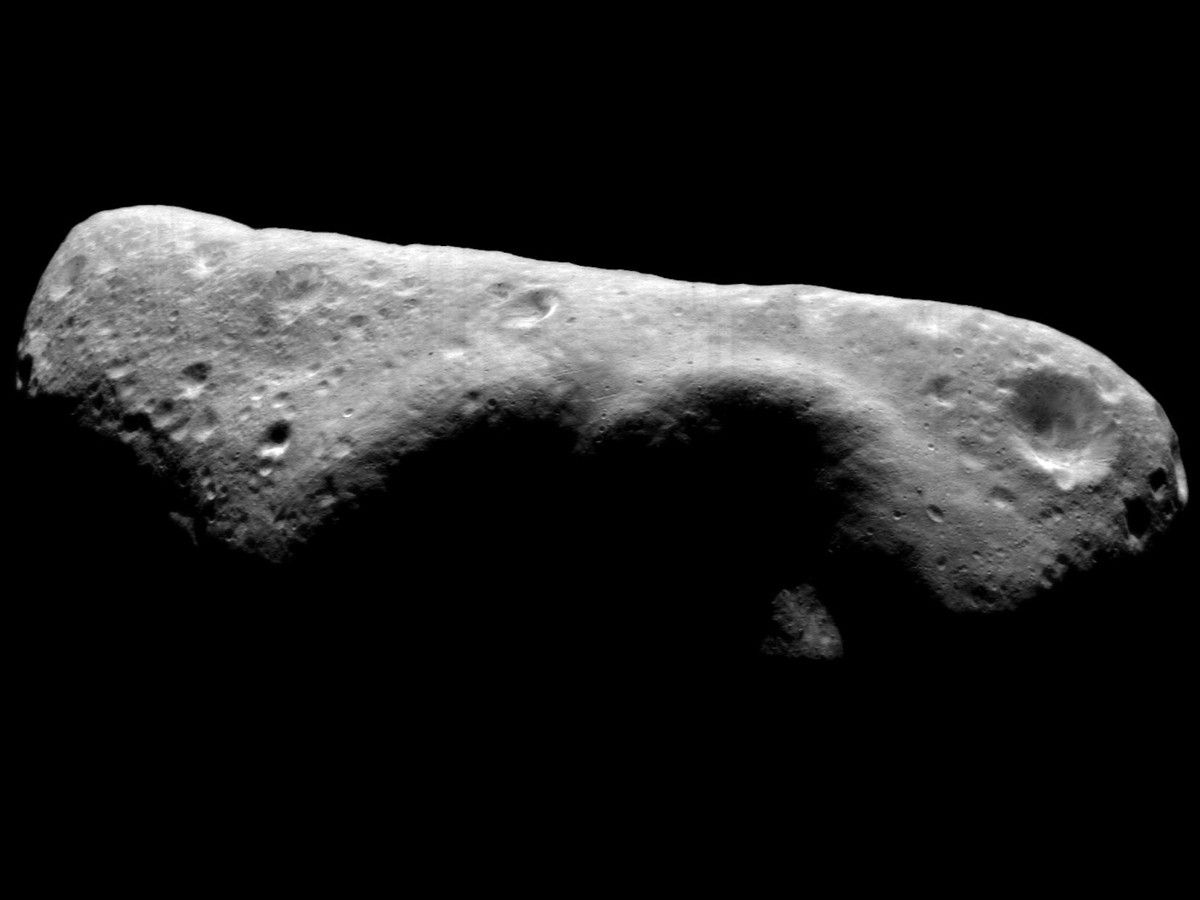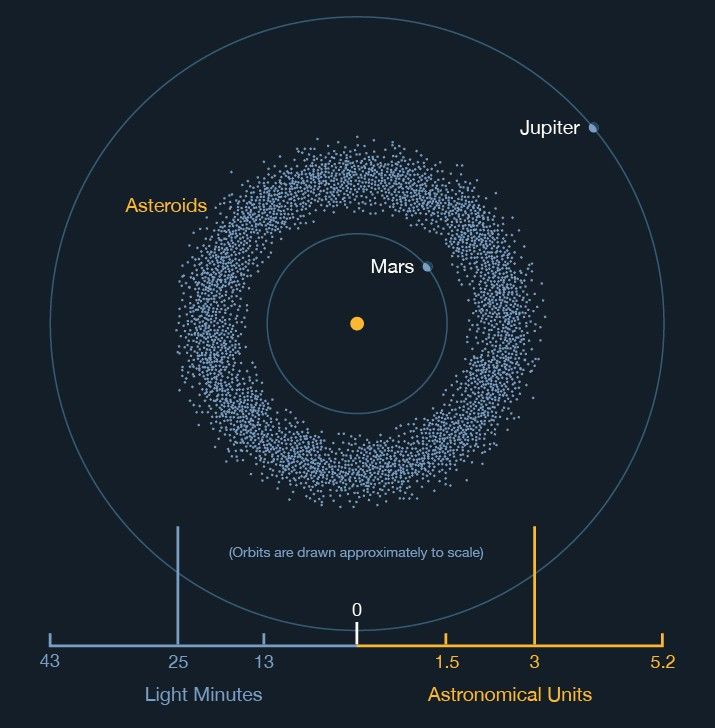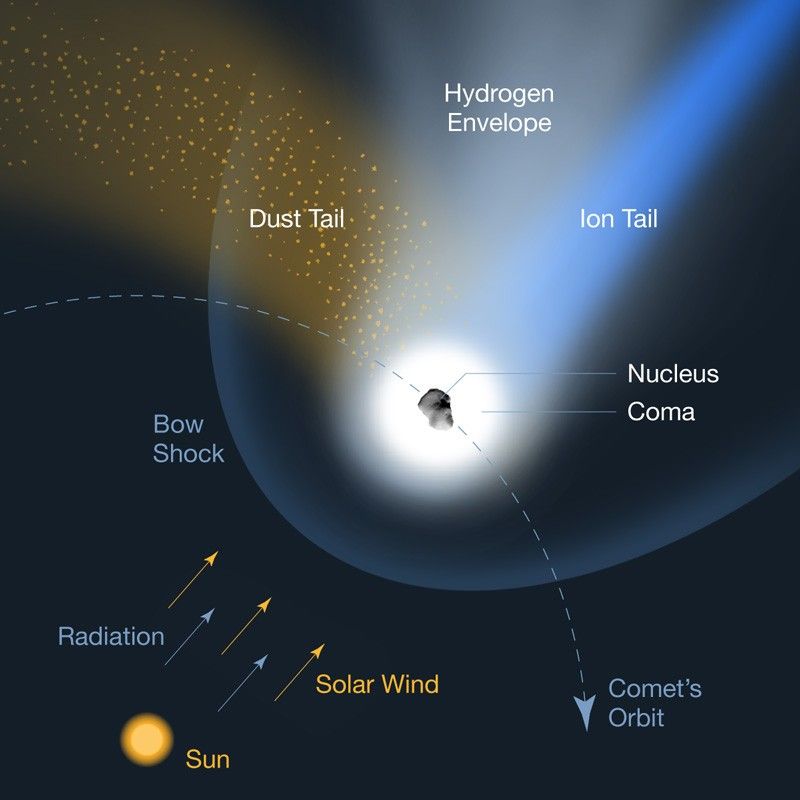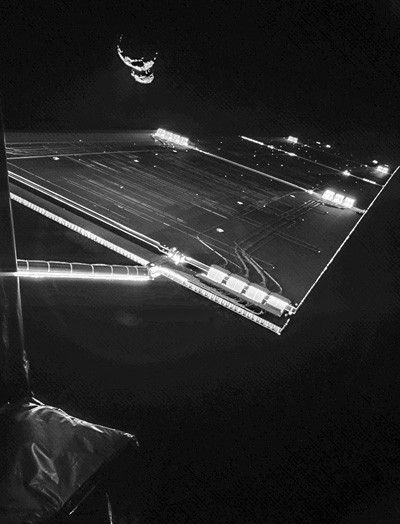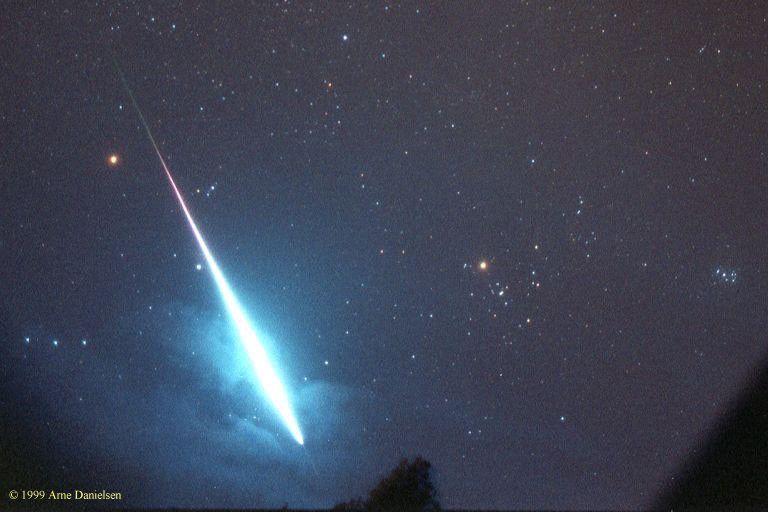Chapter 1: The Solar System
Page One | Page Two | Page Three
The Minor Planets
Minor planets, also called asteroids, are rocky objects in orbit around the Sun. Most orbit in the main asteroid belt between Mars and Jupiter, moving in the same direction as the planets. They range in size from the dwarf planet Eris, which has a diameter of about 2,300 km, down to the size of pebbles. Sixteen have a diameter of 240 km or greater.
Asteroids are classified according to their chemical composition, based on observed spectra and albedo (reflectivity). More than 75 percent are C-type asteroids which are dark and reddish with an albedo less than 0.10. They are similar to carbonaceous chondrite meteorites and exhibit about the same chemical composition as the Sun minus its volatiles. About 17 percent are S-type asteroids, which are brighter, with an albedo of 0.10 to 0.22. They are metallic nickel-iron mixed with iron- and magnesium-silicates. Most of the rest are M-type asteroids, with an albedo of 0.10 to 0.18, made of pure nickel-iron. There are several other rare-composition types of asteroids.
Various spacecraft have crossed the main asteroid belt en route to their destinations, including: Pioneer 10 and Pioneer 11, Voyagers 1 and 2, Ulysses, Galileo (crossed twice), Cassini, New Horizons and Juno.
To their good fortune, none of them ever "discovered" any asteroids by colliding with them. Galileo made observations of two main-belt asteroids, 951 Gaspara and 243 Ida which was found to have its own satellite-asteroid. Cassini imaged the main-belt asteroid 2685 Masursky. (The number N before an asteroid's name means it was the Nth to have its orbit determined.)
There are relatively empty areas between the main concentrations of asteroids in the Main Belt called the Kirkwood gaps, where an object's orbital period would be a simple fraction of Jupiter's. Such a gravitational resonance, over time, causes objects to migrate into different orbits.
The "main belt" asteroids can actually be categorized as divided into two belts, according to confirming data from the Sloan Digital Sky Survey. The inner belt, centered at 2.8 AU from the Sun, contains silicate-rich asteroids, and an outer belt, centered at 3.2 au, contains asteroids rich in carbon.
The Main Asteroid Belt
Some asteroids have orbits outside the main belt, either farther from or closer to the Sun than the main belt. Those which approach Earth are called Near Earth Asteroids, NEAs. Most of the objects which approach Earth are asteroids or "dead" comets, but a few are "live" comets. Together, these asteroids and comets are known as Near Earth Objects.
Near Earth Objects (NEOs)
In terms of orbital elements, NEOs are asteroids and comets with perihelion distance q less than 1.3 au. Near-Earth Comets (NECs) are further restricted to include only short-period comets (i.e., orbital period P less than 200 years). The vast majority of NEOs are asteroids (NEAs). NEAs are divided into groups Aten, Apollo, and Amor according to each one's perihelion distance (q), aphelion distance (Q) and semi-major axis (a). These terms are further discussed in Chapter 5.
| NEO Group | Description | Definition |
|---|---|---|
| NECs | Near-Earth Comets | q < 1.3 au, P< 200 years |
| NEAs | Near-Earth Asteroids | q < 1.3 au |
| Atens | NEAs with semi-major axes smaller than Earth's (named after 2062 Aten). | a < 1.0 au, Q > 0.983 au |
| Apollos | Earth-crossing NEAs with semi-major axes larger than Earth's (named after 1862 Apollo). | a > 1.0 au, q < 1.017 au |
| Amors | Earth-approaching NEAs with orbits exterior to Earth's but interior to Mars' (named after 1221 Amor). | a > 1.0 au, q = 1.017 to 1.3 au |
| Apoheles | Atens with orbits completely interior to Earth's (named after 163693 Atira) | |
| PHAs | Potentially Hazardous Asteroids: NEAs whose Minimum Orbit Intersection Distances (MOID) with Earth are 0.05 au or less and whose absolute magnitudes (H, a measure of brightness, and therefore size) are 22.0 or brighter. | MOID <= 0.05 au, H <= 22.0 |
Other Asteroids
A handful of asteroids have been discovered that orbit the Sun entirely within the Earth's orbit. Asteroid 163693 Atira follows a highly inclined orbit in the area between Mercury and Earth. Its aphelion distance (furthest distance from the Sun), is 0.980 au, less than the Earth's closest distance. Other such objects have been observed, though only Atira has been named.
There are several hundred asteroids located near Jupiter's L4 and L5 Lagrange points (60 degrees ahead and 60 degrees behind Jupiter in its solar orbit), known as Trojans, named after heroes of the Trojan Wars. Mars has a Trojan, and there may be small Trojans in Lagrange points of Earth and Venus.
Small objects in the distant outer solar system might be similar to asteroids or comets; the definitions begin to be unclear. Asteroid-like objects between Saturn and Uranus are called Centaurs. Objects beyond Neptune are called trans-Neptunian objects, or Kuiper Belt objects.
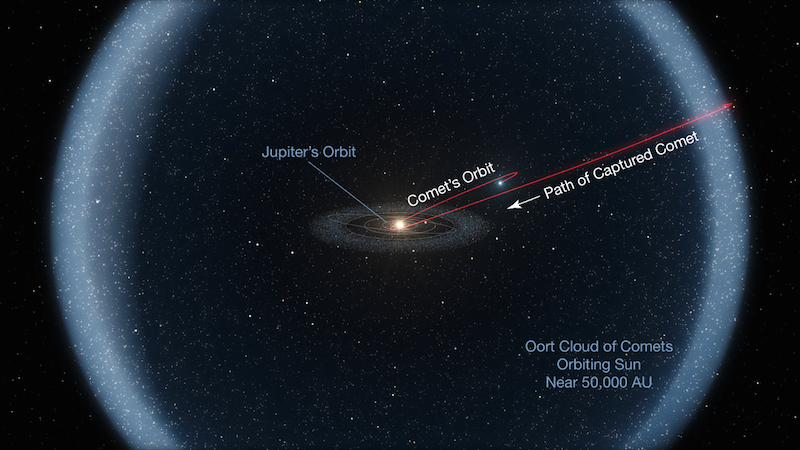
Comets
Comets are formed of rocky material, dust, and water ice. Many have highly elliptical orbits that bring them very close to the Sun and swing them deep into space, often beyond the orbit of Pluto. Unlike the planets, which have orbits in nearly the same plane, comet orbits are oriented randomly in space.
The most widely accepted theory of the origin of comets is that there is a huge cloud of comets called the Oort Cloud (after the Dutch Astronomer Jan H. Oort who proposed the theory), of perhaps 1011 comets orbiting the Sun at a distance of about 50,000 AU (just under a light year). These comets are near the boundary between the gravitational forces of the Sun and the gravitational forces of other stars with which the Sun comes into interstellar proximity every several thousand years. According to the theory, these stellar passings perturb the orbits of the comets within the Oort cloud. As a result, some may be captured by the passing star, some may be lost to interstellar space, and some of their orbits are modified from a relatively circular orbit to an extremely elliptical one coming close to the Sun.
Another reservoir of comets is the Kuiper belt, a disk-shaped region about 30 to 100 AU from the Sun. This is considered to be the source of the short-period comets. The orbit of a Kuiper belt object is sometimes perturbed by gravitational interactions with the Jovian planets causing it to cross Neptune's orbit, where eventually it may have a close encounter with Neptune, either ejecting the comet or throwing it deeper into the solar system.
Comets have been known to break up on closest approach to the Sun. Discovered early in 1993, comet Shoemaker-Levy 9 had broken up apparently because of a close passage to Jupiter. It had been captured into orbit about Jupiter and eventually collided with the planet in July of 1994. The spectacular collision was widely observed. The SOHO spacecraft sometimes watches comets pass by the Sun. This time-lapse movie shows two comets actually colliding with our central star.
Capture and Orbit of a Typical Comet
Comets are practically invisible until they come near the Sun and develop an extended structure. These structures are diverse and very dynamic, but they all include a surrounding cloud of diffuse material, called a coma, that usually grows in size and brightness as the comet approaches the Sun. The dense, inner coma often appears pointlike, but the central body, called the nucleus is rarely seen from Earth because it is too small and dim. The coma and the nucleus together constitute the head of the comet.
Components of a Comet in the Vicinity of the Sun
As some comets approach the Sun they develop enormous tails of luminous material that extend for millions of kilometers from the head, away from the Sun. When far from the Sun, the nucleus is very cold and its material is frozen solid. In this state comets are sometimes referred to as "dirty icebergs" or "dirty snowballs," since over half of their material is ice. Approaching within a few AU of the Sun, the surface of the nucleus begins to warm, and the volatiles evaporate. The evaporated molecules boil off and carry small solid particles with them, forming the comet's coma of gas and dust.
When a coma develops, dust reflects Sunlight, while gas in the coma absorbs ultraviolet radiation and begins to fluoresce. At about 5 AU from the Sun, fluorescence usually becomes more intense than the reflected light.
As the comet absorbs ultraviolet light, chemical processes release hydrogen, which escapes the comet's gravity and forms a hydrogen envelope. This envelope cannot be seen from Earth because its light is absorbed by our atmosphere, but it has been detected by spacecraft.
The Sun's radiation pressure and solar wind accelerate materials away from the comet's head at differing velocities according to the size and mass of the materials. Thus, relatively massive dust tails are accelerated slowly and tend to be curved. The ion tail is much less massive, and is accelerated so greatly that it appears as a nearly straight line extending away from the comet opposite the Sun. This is clearly visible in the time-lapse movie of Comet Hyakutake.
Each time a comet visits the Sun, it loses some of its volatiles. Eventually, it becomes just another rocky mass in the solar system. For this reason, comets are said to be short-lived, on a cosmological time scale. Many believe that some asteroids are extinct comet nuclei, comets that have lost all of their volatiles.
Meteoroids, Meteors, Meteorites
Meteoroids are small, often microscopic, solid particles orbiting the Sun. We see them as meteors ("shooting stars" or "falling stars") when they enter Earth's atmosphere at tens of kilometers per second and burn up.
Heat is generated by compression as the object plows into the atmosphere much faster than the speed of sound, causing the air near the object to glow, while some heat is transferred to the moving object.
On almost any dark night, at least a few meteors may be seen. There are many more during several yearly meteor showers. Some display impressive fireballs, leaving cloudy trails behind. Any part of a meteor that reaches the ground is called a meteorite.
As volatiles boil or sublimate from comets, they carry small solid particles with them. Particles released from comets in this way becomes a source for meteoroids, causing meteor showers as the Earth passes through them.
Since Earth and meteoroid orbits have a fixed relationship, meteor showers appear to originate at a point in the sky, as seen from Earth's surface, called the "radiant." For example, each autumn observers see the Leonoid meteors appear to radiate from within the constellation Leo. Meteoroids also come from the asteroid belt.
Some rare meteoroids are actually debris lofted from the Moon or Mars as the result of large impacts on those bodies.






























